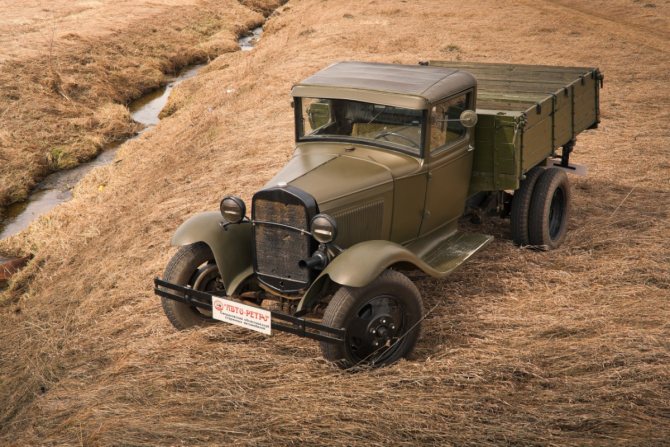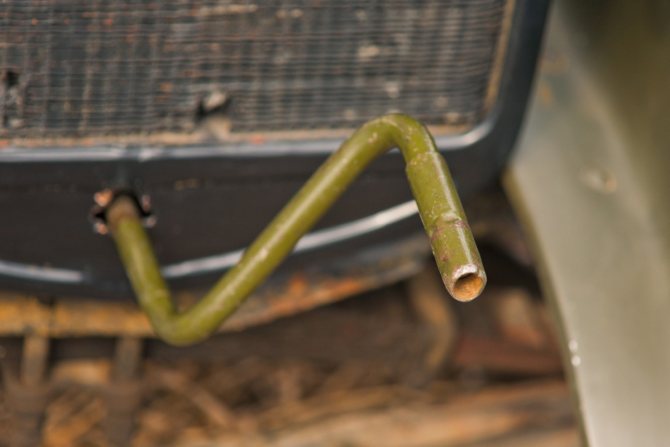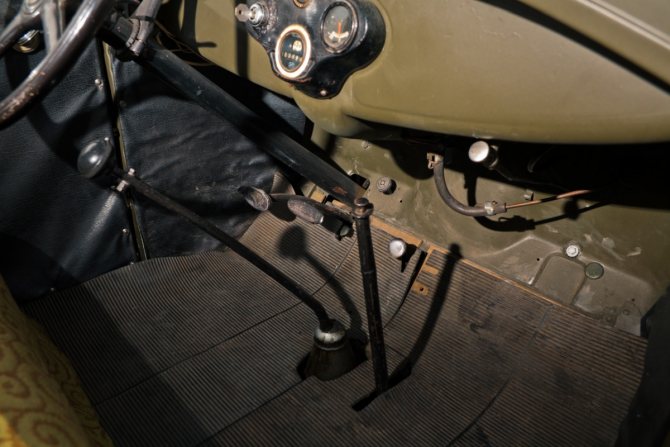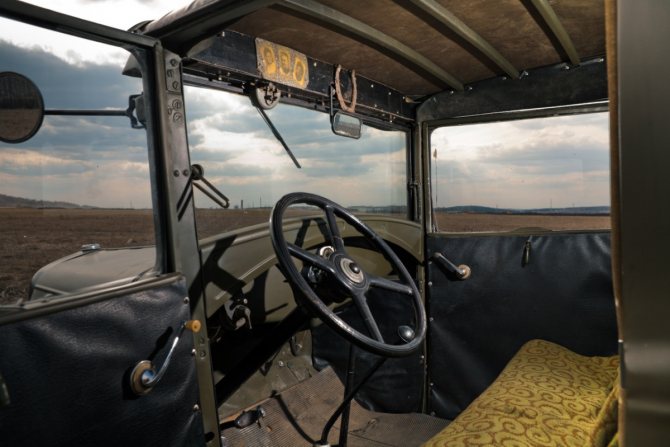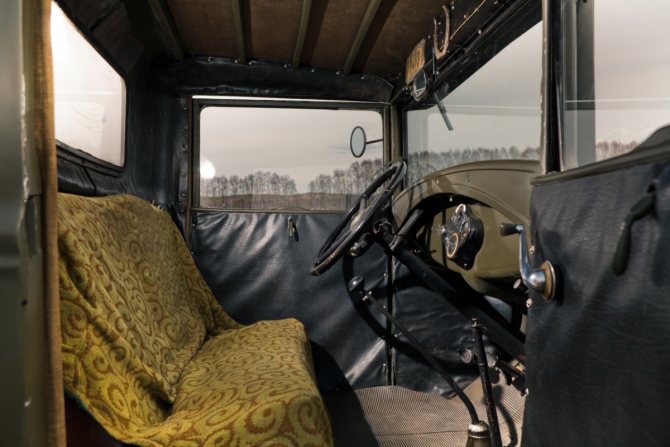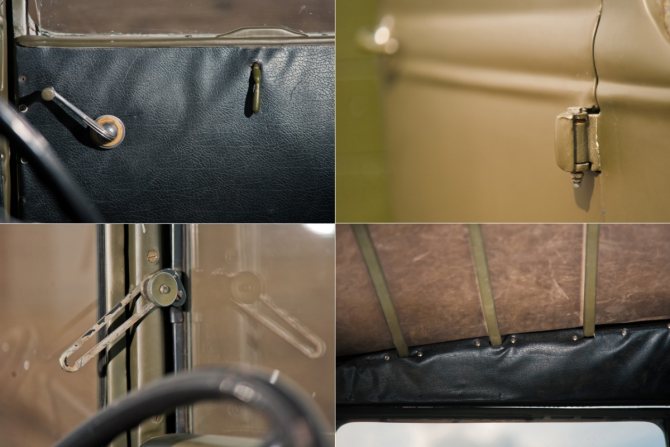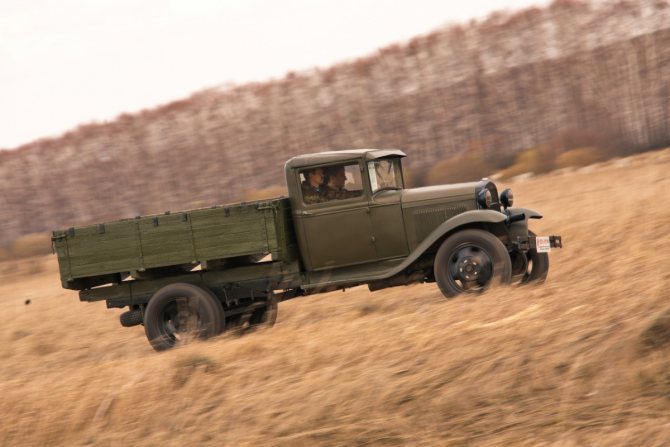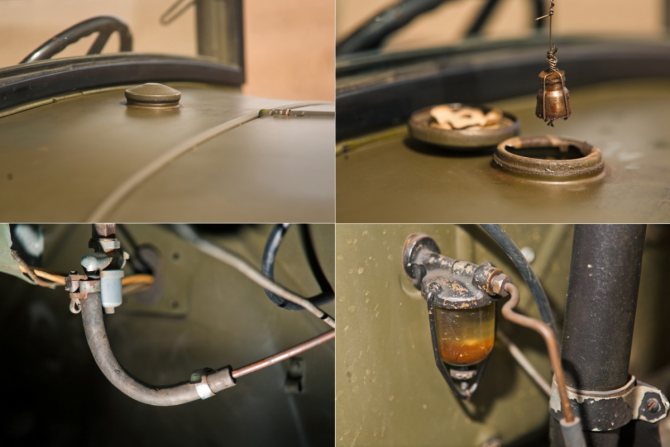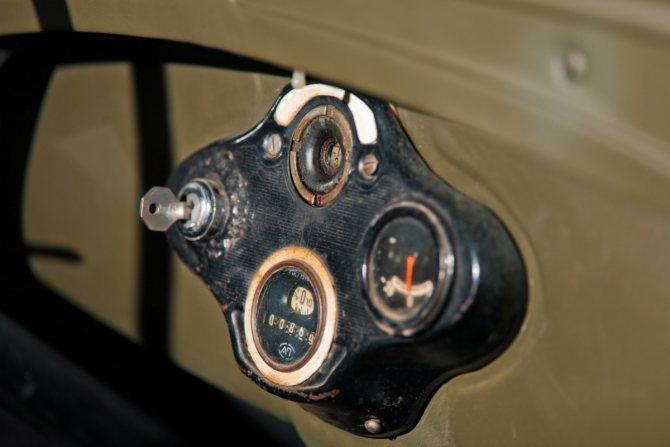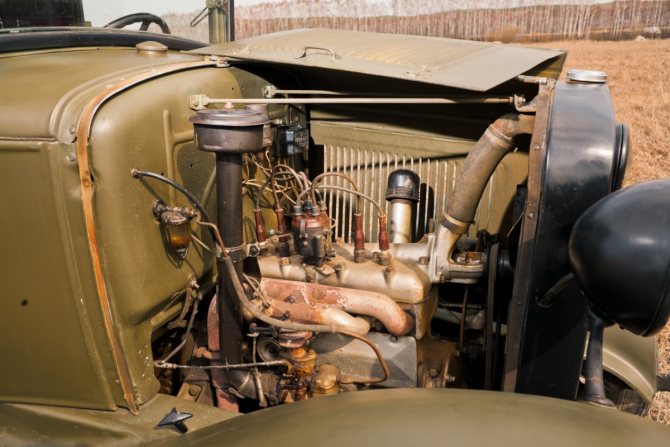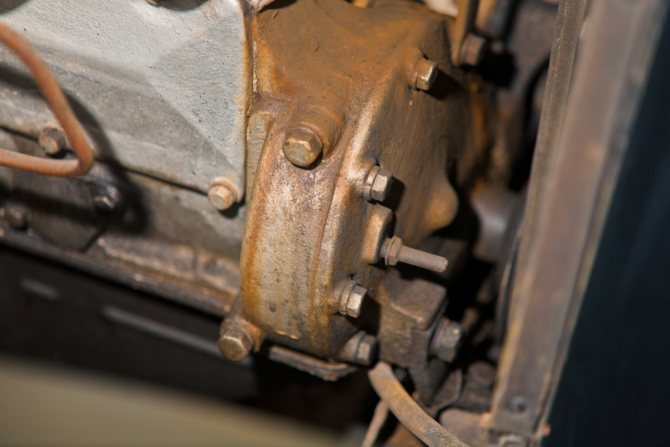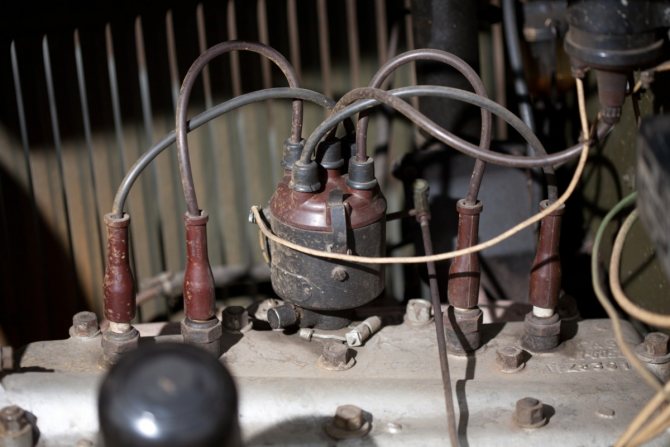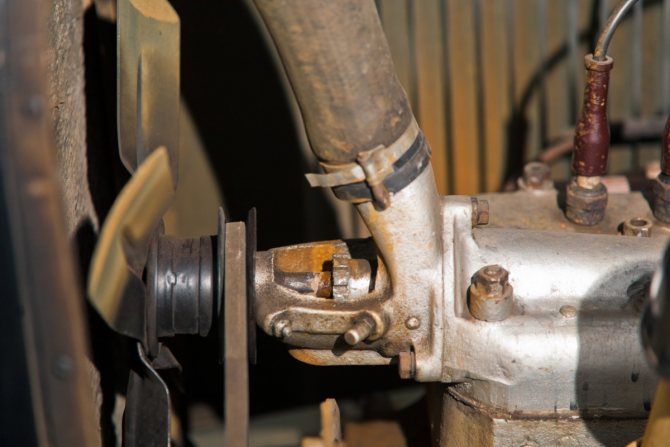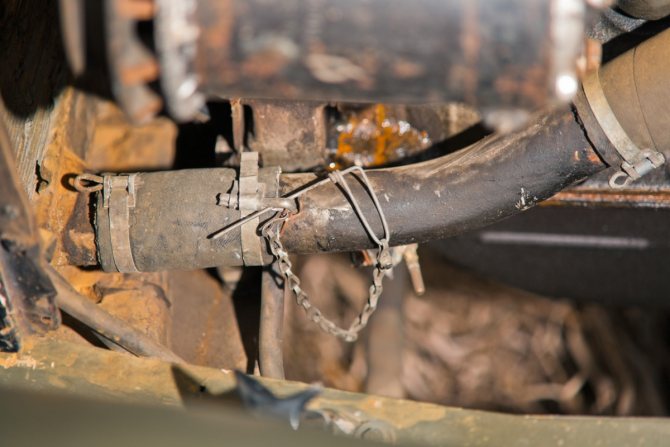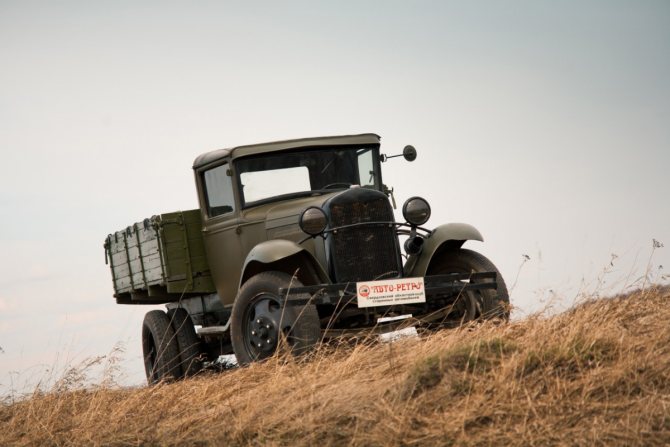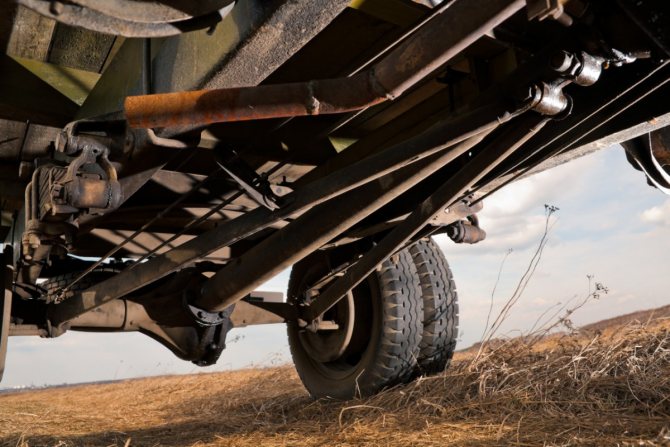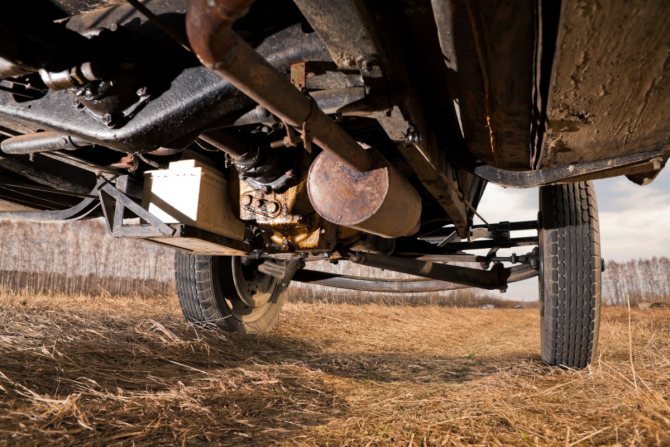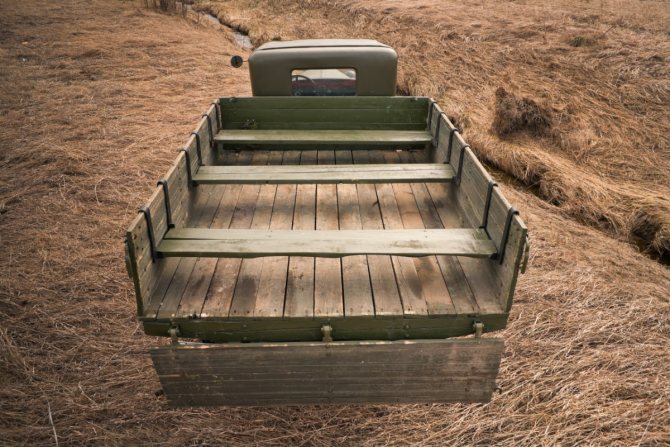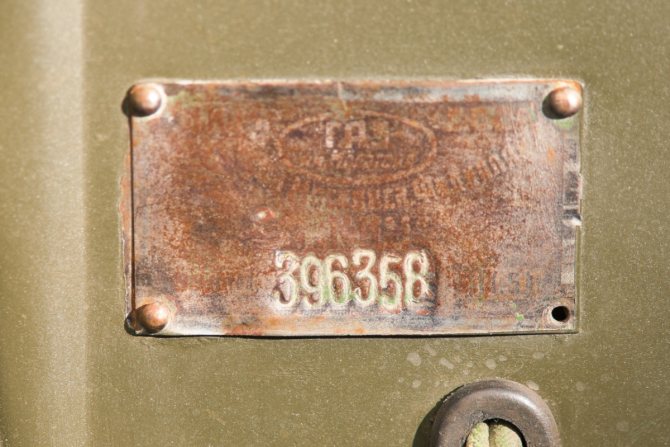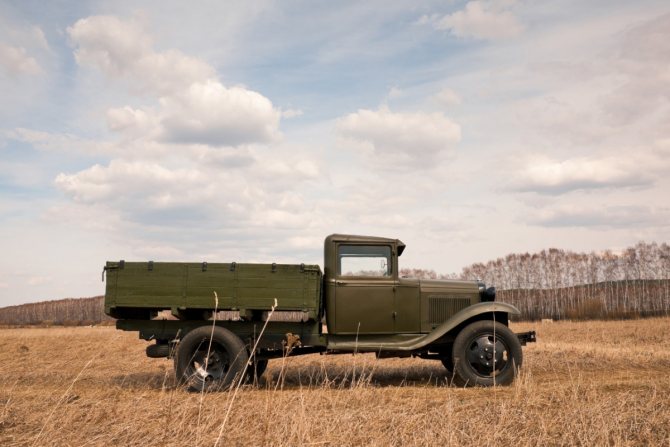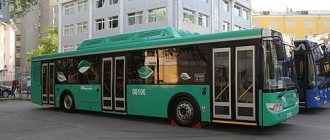| GAZ-AA | |||||||||||||||||||||||||||||||||||
| Total information | |||||||||||||||||||||||||||||||||||
| Manufacturer | GAS | ||||||||||||||||||||||||||||||||||
| Years of production | 1932—1938 | ||||||||||||||||||||||||||||||||||
| Assembly | GAZ (Gorky, USSR) KIM (Moscow, USSR) | ||||||||||||||||||||||||||||||||||
| Class | 1.5 tons | ||||||||||||||||||||||||||||||||||
| Other designations | “Gazik”, “lorry”, “polundra” | ||||||||||||||||||||||||||||||||||
| Design | |||||||||||||||||||||||||||||||||||
| Platform | Ford AA 1930 model | ||||||||||||||||||||||||||||||||||
| Layout | front-engine, rear-wheel drive | ||||||||||||||||||||||||||||||||||
| Wheel formula | 4 × 2 | ||||||||||||||||||||||||||||||||||
| Engine | |||||||||||||||||||||||||||||||||||
| |||||||||||||||||||||||||||||||||||
| Transmission | |||||||||||||||||||||||||||||||||||
| 4-st. Manual transmission | |||||||||||||||||||||||||||||||||||
| Weight and dimensions characteristics | |||||||||||||||||||||||||||||||||||
| Length | 5335 mm | ||||||||||||||||||||||||||||||||||
| Width | 2030 mm | ||||||||||||||||||||||||||||||||||
| Height | 1870 mm | ||||||||||||||||||||||||||||||||||
| Clearance | 200 mm | ||||||||||||||||||||||||||||||||||
| Wheelbase | 3340 mm | ||||||||||||||||||||||||||||||||||
| Weight | 1750 kg | ||||||||||||||||||||||||||||||||||
| On the market | |||||||||||||||||||||||||||||||||||
| Related | GAZ-MM, GAZ-AAA | ||||||||||||||||||||||||||||||||||
| Other information | |||||||||||||||||||||||||||||||||||
| Load capacity | 1500 kg | ||||||||||||||||||||||||||||||||||
| ← Ford Model AA 1930 GAZ-MM → | |||||||||||||||||||||||||||||||||||
| Media files on Wikimedia Commons | |||||||||||||||||||||||||||||||||||
GAZ-AA produced 1934-1938.
USSR postage stamp (1974) GAZ-AA
(
"lorry"
) - a Soviet truck from Nizhny Novgorod (in 1932), later from the Gorky Automobile Plant, with a load capacity of 1.5 tons (1500 kg), known as
a lorry
. The model was an American Ford model AA truck from 1930, but was subsequently redesigned according to domestic drawings.
Story
Initially, 10 samples of the American Ford model AA truck of the 1930 model were produced in Kanavin, but subsequently, before the launch of the Nizhny Novgorod Automobile Plant (NAZ), Soviet engineers prepared their own drawings, revising the design, components, platform, and already the first serial NAZ-AA rolled off the assembly line NAZ January 29, 1932. By the end of the year, the plant, renamed after the city as Gorky Automobile, was producing 60 GAZ-AA trucks per day. Unlike the American Ford model AA, the GAZ-AA had a strengthened clutch housing, steering mechanism, an air filter, and an onboard body was designed back in 1930 according to Soviet drawings. GAZ-AA has been assembled entirely from Soviet components since 1933. Until 1934, the cabin was made of wood and pressed cardboard, and then was replaced by a metal cabin with a leatherette roof.
In 1938, the truck was modernized and received a GAZ-MM engine with a power of 50 hp. p.[1] (its GAZ-M modification was installed on the GAZ-M1 Molotovets-1 passenger car, better known as Emka), reinforced suspension and a new steering mechanism and driveshaft. There were no external differences between the GAZ-AA and the GAZ-MM.
There was also a modification of the GAZ-AA with a dump body, at the beginning of production it was called GAZ-S1, later GAZ-410. The principle of operation of this dump truck was quite interesting: the load, evenly distributed in the body, should have tipped the platform back under its own weight, if not for a special locking device, the handle of which was located in the middle of the left side.
To unload, the driver released the handle, the cargo was poured back, and the empty body returned to a horizontal position under the influence of gravity, after which it was fixed using the handle. [ source not specified 377 days
]
Soon after the start of the Great Patriotic War, due to a lack of thin cold-rolled steel and a number of components supplied by third-party companies, GAZ was forced to switch to the production of a simplified military truck GAZ-MM-V (in-house index MM-13) with non-folding side walls, which has doors were replaced by triangular side barriers and rollable canvas doors, the fenders were made of roofing iron using a simple bending method, there were no brakes on the front wheels, and only one headlight was left.
In 1944, the pre-war equipment was partially restored: wooden doors appeared, that is, the cabin again became wooden and metal (and remained so until the end of the truck's production), later front brakes, folding side walls and a second headlight appeared again. The last GAZ-MM rolled off the Gorky assembly line on October 10, 1949.
For another year (and according to some sources, until 1956), the “lorry” was assembled in Ulyanovsk, where they were produced since 1947.
Years of production of NAZ (GAZ)-AA/GAZ-MM: at NAZ/GAZ - 1932-1949; at the Moscow KIM plant - 1933-1939; at the Rostov Automobile Assembly Plant - 1939-1941; at UlZiS - 1947-1950. 985,000 copies of GAZ-AA, GAZ-MM and their derivatives were produced, including 138,600 during 1941-1945.
By the beginning of the Great Patriotic War, there were 151,100 such vehicles in the ranks of the Red Army. Thus, the “lorry” became the most popular Soviet car of the first half of the 20th century; they could be found on the country’s roads until the end of the 1960s [ source not specified 1125 days
].
Design Features
| This section is missing references to information sources. Information must be verifiable, otherwise it may be questioned and deleted. You may edit this article to include links to authoritative sources. This mark was set on August 12, 2020 . |
Structurally, the GAZ-AA truck is simple and technologically advanced and was made according to the classical design on a frame chassis with spring suspension. The cabin plumage is unified with the GAZ-A passenger car.
A special feature of the design was the design of the rear suspension and transmission, where the so-called push tube (English torque tube) was used as a longitudinal thrust, inside of which there was a closed driveshaft, which rested against a bronze bushing, subject to rapid wear and the need for frequent repairs. The fastening of the reaction rod of the front suspension, which absorbed the force during braking, also had insufficient survivability. Accordingly, the failure mileage of the “one and a half” was significantly less than that of the “three-ton” ZIS-5, moreover, the “one and a half” was almost always operated with a significant (up to twofold) overload.
Thanks to the low compression ratio (4.25:1), the unpretentious and repairable GAZ-AA and GAZ-MM engines could be operated on the lowest grades of fuel, including naphtha and even kerosene (in the warm season and on a warm engine) and low-quality industrial lubricating oils (autols and nigrols).
Scarce starters with a battery had a low resource (on a rare car they lasted more than six months), so in real operation the car was started with a “crooked starter,” that is, with a crank.
Tires with low mileage were a particular shortage (8-9 thousand km compared to the standard 20 thousand km), so in the late 1930s and during the war, semi-trucks often rolled off the assembly line with only two rear wheels, that is, with a single tire rear axle, which, accordingly, reduced the load capacity. Wheels - 6.5-20″, I-4.
Nevertheless, thanks to mass conveyor production, the GAZ-AA/MM was the most popular truck, and indeed car in general, in the pre-war USSR and in the Red Army (over 150 thousand as of 06/20/1941).
Its chassis served as the basis for the creation of a number of specialized and special modifications for military and civilian purposes: charging and lighting power stations, radio stations, the RUS-2 early warning radio system, radio workshops and repair “flights”, auto laboratories for sanitary, hygienic and anti-chemical purposes, fuel and oil refillers , airfield launch vehicles, acoustic and light air defense installations, various tanks, watering machines, ambulances, etc.
GAZ-AA and -MM units were widely used in the creation of military vehicles, including light tanks T-37 and T-38, armored vehicles BA-6 and BA-10, self-propelled gun SU-12 with a 76.2-mm regimental gun, artillery tractors , "Katyusha" BM-8-36 and other equipment.
- Rear axle on longitudinal semi-elliptic springs (cantilever suspension)
- The propeller shaft runs in a pipe, which also serves as a torque rod for the rear axle
- Fastening the pipe with the driveshaft to the gearbox, the flexible speedometer drive cable is visible
- Front axle on a transverse semi-elliptical spring, visible traction to the brake mechanism
- GAZ-AA, engine, right side
- GAZ-AA, engine, left side
- GAZ-AA, distributor with remote adjustment of ignition timing
GAZ-AA “Polutorka”: A small truck of a big country
But even a person far from cars nods happily at the mention of this car’s nickname - a lorry. We know, we know, we heard!
And who knows, the lorry is immortalized in poems, songs and films about the Great Patriotic War. At the beginning of the forties, GAZ-AA, due to its manufacturability and low production costs, was not only the most popular truck, but generally the most popular vehicle in the Red Army.
| The carrying capacity of the GAZ-AA is one and a half tons, hence the name - lorry. But often these machines were operated with overload, often double. |
The semi-trucks served not only for their intended purpose - as trucks, they were used both as light tractors and as “passenger” flyers. The chassis of gas vehicles were used for numerous special modifications for military and civilian purposes: radio stations, repair shops, ambulances, tankers and even aircraft starters.
DShK or quad Maximum machine guns, or even 25-mm automatic cannons, were installed in the bodies of GAZ vehicles. The units of this massive truck were used to create the BA-6 and BA-10 armored vehicles, as well as the SU-12 self-propelled gun, artillery tractors and the BM-8-48 Katyusha.
It is truly difficult to overestimate the contribution of this car to the victory. The Nazis also well understood the role of the Gorky Automobile Plant in providing our army with military equipment. During the days of preparation for the offensive on the Kursk Bulge, German aviation carried out 25 air raids on the plant. The enterprise suffered significant damage, but despite the bombing, the production of defense products, including one and a half, continued.

Unfortunately, few of these veteran cars have survived to this day. Until 1986, it was prohibited for private individuals to own trucks in the USSR. Automotive companies handed over old cars for scrap metal - the country had annual standards for the delivery of recyclable materials.
Some of the cars have been preserved as monuments to military drivers. However, rains and snowfalls have left these semi-trucks in a deplorable state; in addition, on pedestals there are often cars produced after the war.
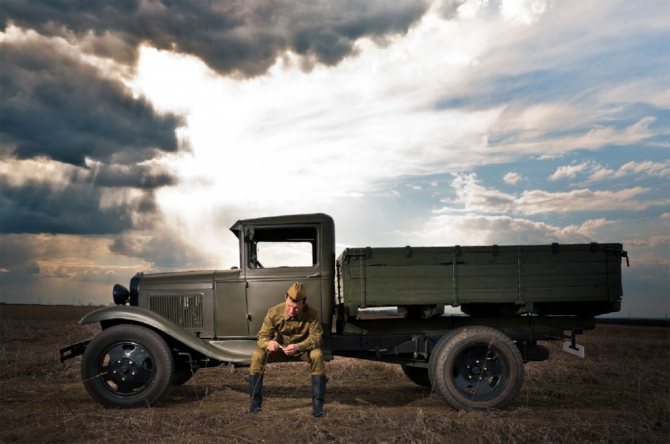
But the hero of our report is not only produced in 1936, but also in good working order and in completely authentic condition! This GAZ was lucky; it was operated for a long time at the plant named after. Kalinin, and then eventually fell into private hands, to one of the former employees of the enterprise.
In 1998, the lorry was bought and restored by our good old friends - enthusiasts of the Avtoretro club. On May 9, GAZik will take part in a traditional exhibition of retro cars followed by a motor rally around Yekaterinburg, and today we have the opportunity to get to know it better.
|
| In terms of size, the GAZ-AA is comparable to an average modern pickup truck. The cabin is absolutely tiny - it’s cramped for both two and one. And this is in summer clothes. What was it like for the drivers of that time to drive lorries in short fur coats and felt boots! |
Structurally, the GAZ-AA is a modified Ford-AA, taking into account our conditions; this model replaced the Ford-TT, the cargo brother of the legendary Ford-T. But there is no talk of any “piracy”. The enterprising Henry Ford himself was happy to cooperate with the Soviets and provided comprehensive technical support not only in mastering the production of his models, but also in building a car plant.
The reason for this is the Great Depression. If not for her, the history of the Soviet automobile industry might have been different. And who knows, there would have been a place in it for a semi, and indeed for the Gorky Automobile Plant.

That's not to say the dark green truck looks brand new. Tubes on the radiator are sealed in many places, some boards in the body have been replaced - this is more likely to be the look of a hard-working car that a caring driver has driven for inspection. Smooth curves of the front wings, a steel cabin - by all appearances, this GAZ-AA is from a pre-war production year.
During the war, simplified lorries came out of the factory gates: with wings bent from roofing iron, wooden cabins, with one headlight, without a front bumper, and sometimes without doors; their role was played by canvas rollers. There were no front brakes, and only the tailgate opened in the back.
But the war also affected our hero; he looks at the world with squinted headlights.
Shall we try to start it? They say that the starters on the lorry were not particularly reliable. A rare starter lasted more than six months, so drivers quickly switched to a “crooked” starter.
|
| The handle of the “crooked starter” passes very close to the wings - it’s easy to peel the skin on your hands, which is what I did. |
I skinned my fingers, but the engine still didn’t start. However, on our copy it is possible without extremes - the starter is working, the engine starts by pressing a button! The button is located in the floor, the key on the dashboard only turns on the ignition.
A couple of cranks and the engine comes to life. Then the revolutions drop, so that it seems that the engine has stalled, but this only seems to be the case - there is simply a very low-speed unit under the hood.
|
| The clutch and brake pedals are located so high from the floor that before you press them, you have to pull your legs up to your stomach; you can’t use your toes alone. The polished “penny” in the area of the rubber mat is the gas pedal, a little higher and to the left is the starter button. The difference in height between the gas and the brake is huge, and besides, the right edge of the brake pedal is bent upward. |
|
| The steering wheel is large, but standing still you still can’t turn the wheel, only while driving – there is no power booster. Under the ceiling of the cabin there is a horseshoe for luck and photographs of girls... from the forties. There is only one windshield wiper, and it is pneumatically driven. |
The clutch pedal is surprisingly lighter than you'd expect, and getting into first gear was easy. The main thing now is not to accelerate; high speeds are contraindicated for this engine. Let's go!
As soon as the semi-truck starts moving, you can switch to the second one, but for this you need to do a double squeeze. While I was doing this, the GAZ almost stopped and after turning on the second one, it stalled. I step on the starter button and try again, this time I was able to pull out the engine in second gear. It gets easier. The third, and now the fourth, although we are driving 30 kilometers per hour. The speedometer does not work; the restorers were unable to find the drive cable.
|
| The seat resembles a bench - you sit as if you had swallowed an arshin, and naturally, there are no adjustments. The cabin doors were adjusted not so long ago, but they quickly sagged (there is a decent gap between the glass frame and the roof), but they close like on a good foreign car! Smack. That's all. |
|
| To slam the door, you need to grab the small protrusion on the top edge, open it - pull the green lever up. For better ventilation, the windshield can be raised on a special bracket. To save sheet metal, the roof is covered with a piece of leatherette. |
Now I need to make a U-turn, I try to turn on the second one and turn off the engine again. I forgot that when moving down, you can’t get by with double squeezing - you need to re-throttle. But reverse gear is engaged quite easily, you just need to first click a special flag on the gearshift lever.
And water splashes out under the radiator plugs onto the hood. It’s normal that there is no expansion tank.
|
| If we compare the GAZ-AA with the Ford GPW, which we drove a year ago, then shifting gears on a semi-truck is easier, perhaps this is a feature of this car. But the jeep has a much lighter steering wheel, a smoother ride, and it’s also faster—think of it as a passenger car. |
The 3.3-liter inline-four produces 40 hp. With. at 2200 rpm. The torque value cannot be found on the Internet, only in old reference books - 15.5 kgf*s, if translated into “our money”, it will be 152 N.m.
But this engine is not strong in its characteristics, but in its omnivorousness. Gasoline with an octane rating of 52 is suitable. You can pour naphtha and kerosene, the latter, however, already into a running and warmed-up engine. And in besieged Leningrad, semi-trucks ran on hydrogen downloaded from balloons. The engine is also unpretentious to motor oil.
Today the car was pampered with 80-octane gasoline, pouring several liters from a can into the tank, which is located between the engine and the cabin.
|
| There is no fuel pump on the GAZ-AA, the tank is located high, and the fuel enters the carburetor by gravity. Under the instrument panel on the fuel line there is a tap, which is recommended to be closed during long-term parking, otherwise there is a possibility that all the gasoline will leak out through an insufficiently sealed float chamber. A mesh with a magnet suspended from it is inserted into the neck of the tank to catch metal particles, given the quality of the fuel of that time - this precaution was not superfluous. |
|
| That's the entire dashboard - speedometer, odometer, ammeter and fuel level sensor. The latter is made in a very original way, gasoline splashes behind its glass (!), and a float with divisions swims in it. The accuracy of the readings, however, is very conditional. |
Despite its simplicity, the GAZ-AA was a fairly progressive design for the first half of the 30s. A modern motorist, opening the hood flaps of a semi-truck, will discover many familiar and at the same time unusual technical solutions:
|
| On the right side are the intake and exhaust manifolds. The carburetor is crowned with a tiny air filter with an oil bath. The carburetor itself has an upward air flow, unlike modern carburetors, which have a downward flow. |
|
| And this is the timing belt. In GAZ-AA, not only the camshaft, but also the valves are located at the bottom of the engine. A little to the left is the standard place for the fuel pump (!), covered with a diamond-shaped cover with two bolts; apparently, Ford also had more advanced versions of this engine |
|
| There is no block head as such, just a cover into which the spark plugs are screwed. There is a rod connected to the distributor-distributor, with the help of which the driver can adjust the ignition timing directly from the cab. |
|
| The generator and starter are mounted on the left side of the block. |
|
| One of the interesting technical nuances is the open shaft of the pump... |
|
| ...and the oil filler neck, which also serves as a crankcase ventilation breather; for this purpose, a special filter is put on it. |
|
| To clean the drain valve of the cooling system, the designers of this motor provided a miraculously bent wire on a chain. Cute. |
|
| “But the pump is leaking! No, we won’t get to Berlin with such fanfare.” |
Riding in a passenger seat has its own characteristics. Legs together, feet at a 45-degree angle, back straight. In principle, you can go, but you want to take on something, but nothing. The inner surface of the doors is absolutely smooth, there are no handrails, all you have to do is grab the upper edge of the front panel with the fingers of your left hand, because while driving the car shakes at every slight unevenness. And how could it be otherwise - the curb weight is small, the suspension of all wheels is spring, there are no shock absorbers.
It's +15 outside. This temperature is optimal for traveling by lorry. In warmer weather, the engine noticeably heats up the cabin, but this heating does not help in winter, there are many cracks. In the floor, through the hole for the steering shaft, you can generally see the road!
The speed is 40 km/h, the truck can do more, but it will not be easy for the riders to survive such shaking. So, having hit a deep hollow with its front wheels, the lorry bucked so much that I almost hit my head on the wooden slats of the roof on which the leatherette canopy rests. But the dashing drivers of that time accelerated their GAZ cars to the passport speed of 70 km/h, or even more!
|
| At the front there is one transverse spring with push rods that transfer loads to the frame. |
|
| Rear springs are “Cantilever” type. |
|
| The transmission, by today's standards, is also original. The driveshaft is located inside a so-called pusher tube, which rests against a bronze bushing. The bushing, in turn, was subject to rapid wear, which necessitated frequent repairs. |
|
| In front everything is more familiar. You can get to the battery through a special hatch in the floor. |
On the road, the GAZ-AA arouses increased interest. Pedestrians stop and motorists honk. Truck drivers especially stand out. Relatives! It's a rare truck that doesn't sound its diesel horn.
Ekaterinburg residents are generally good people, they were only slightly spoiled by the “traffic” issue. When the traffic began to thicken, many people appeared who wanted to change lanes in front of the steel bumper of the rarity.
The mechanically driven brakes of the lorry were not particularly effective in its youth, but today, while the original traction takes out all the play, the car manages to run about three meters. The hand brake, by the way, is also unusual - a band brake, not a shoe brake.
|
| To transport fighters, the trucks were equipped with removable benches. When transporting cargo, the benches could be easily removed by placing them on the bottom of the body. GAZ-AA could carry up to 16 people. |
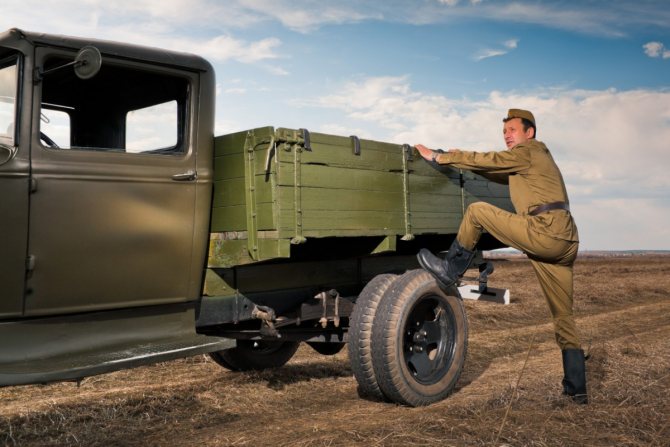
And yet, no traffic jams, hasty neighbors downstream, or a cramped cabin and shaking suspension can overcome the positive mood that covers you behind the wheel of a semi-truck.
It is joyful that this small car, having shouldered all the hardships of the war on its springs, survived. While inferior to the Wehrmacht vehicles in terms of technical characteristics, it surpassed them in unpretentiousness and maintainability - and won. It is also joyful that people withstood the hardships of that war. And they won.

Operating experience
Due to the speedometer not working (and for a long time now), it is not possible to determine the exact mileage of the car. The approximate mileage, presumably, is not that great. In-plant operation does not involve large hauls. And since the time the car has been in the collection of the Avtoretro club, it has driven approximately 50 km a year.
|
| The club's restorers had great difficulty in removing the rust from the original plate with the chassis number. |
Since the restoration in 1998, the club's mechanics had to re-weld, putty and paint the cabin three years ago. We also changed the oil seal packing of the pump, replaced all the hoses of the cooling system and fuel lines - the rubber simply dried out.
|
| Engine number. |
Several rotten boards had to be replaced in the body—the entire front side. Not so long ago, having found the necessary bracket, the spare tire was hung under the bottom “factory style”; previously it just lay in the back of the car.
I had to glue the wheel tubes two more times, but that doesn’t count anymore.
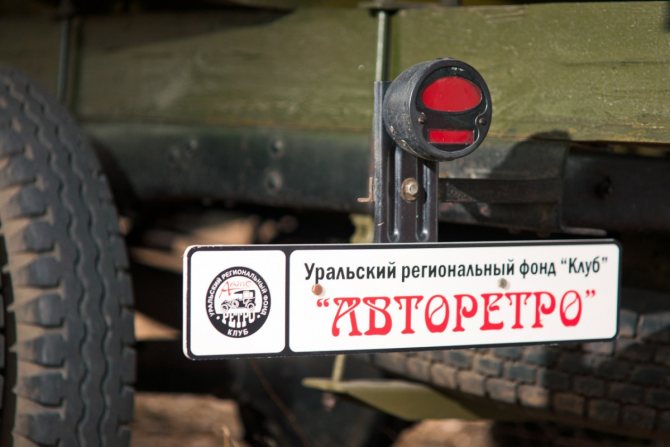
| GAZ-AA | ||
| Engine | gasoline, carburetor, 4-stroke, lower valve | |
| Number of cylinders | 4 | |
| Working volume, cm³ | 3285 | |
| Max. power, hp/rpm | 40/2200 | |
| Max. torque, kgf*m (Nm) | 15,5 (152) | |
| Drive unit | rear | |
| Transmission | manual, 4-speed, not synchronized | |
| Front suspension | dependent, on a transverse semi-elliptical spring with push rods | |
| Rear suspension | dependent, on two longitudinal cantilever springs, without shock absorbers | |
| Front brakes | drums | |
| Rear brakes | drums | |
| Maximum speed, km/h | 70 | |
| Acceleration time 0-100 km/h, sec. | — | |
| Dimensions, mm | ||
| length | 5335 | |
| width | 2040 | |
| height | 1970 | |
| wheelbase | 3340 | |
| ground clearance | 200 | |
| Curb weight, kg | 1810 | |
| Tires, inches | 6.50 – 20 | |
| Load capacity, kg | 1500 | |
| Fuel consumption, l/100 km | ||
| urban cycle | — | |
| suburban cycle | — | |
| mixed cycle | 20.5 | |
| Fuel tank capacity, l | 40 | |
|
| Text: Constantin Gheorghe Photo: Nikolay Kovalevsky In the role of a soldier-driver: manager of the Avtoretro club Igor Arkadyevich Arbuzov |
We express our gratitude to all members of the club and personally to the chairman of the board of trustees, Dmitry Borisovich Baskov, for their assistance in conducting the test.
66.RU
Main modifications based on GAZ-AA and GAZ-MM
Trucks: AMO-F-15, GAZ-AA, ZIS-5V. Russian postage stamp, 2007
- GAZ-AAA is a six-wheeled (three-axle with a 6 × 4 wheel arrangement) off-road truck, payload capacity 2.0 tons. Created on the basis of a licensed Ford-Timken truck of the 1931 model. Years of production: 1934—1943. In 1937, it received a more powerful (50 hp) engine and other components from GAZ-MM. The total output until 1943 was 37,373 units. On the basis of GAZ-AAA, the GAZ-05-193 headquarters bus (1936-1945), as well as serial armored vehicles BA-6 (1936-1938, 394 units), BA-10A (1938-1939) and BA-10M ( 1939-1941, a total of 3331 units). At the end of the 1930s, the armored hulls of worn-out armored vehicles of early series were transferred to the shortened GAZ-AAA chassis, thus the BA-27M (1937-1938), BAI-M and BA-3M (1939-1940) armored vehicles were obtained. In addition, experimental BA-6 m and BA-9 were created; experimental amphibious armored vehicles PB-4 (1933-1934, 6 units) and PB-7 (1936/37, 1 unit). The BKhM-1 chemical combat vehicle was produced (1935-1937), and an experimental ambulance BA-22 armored personnel carrier for 10 wounded was created (1937).[2]
- BA-10 - in the fall of 1941 - in the spring of 1942, the remaining batch of BA-10M armored hulls remaining at the Izhora plant was delivered to the GAZ-MM two-axle chassis. These armored vehicles were delivered only to the Leningrad Front.
- GAZ-410 is a dump truck on the GAZ-AA and GAZ-MM chassis, load capacity 1.2 tons, all-metal body of self-unloading type. Years of production: 1934—1946.
- GAZ-42 is a gas generator modification that used wooden lumps as fuel. Engine power - 35-38 hp. pp., rated load capacity is 1.0 t (the actual one is less, since a significant part of the shortened platform was occupied by a 150-200 kg supply of lumps). Years of production: 1938—1950.
- GAZ-43 is a coal-fired gas generator version. It was distinguished by the smaller dimensions of the gas generator installation. Produced in small quantities in 1938-1941.
- GAZ-44 is a gas-cylinder version using compressed gas. Gas cylinders were located under the cargo platform. Released in a small batch in 1939.
The first production cars were equipped with a NATI-SG6 gearbox, which was later replaced by a NATI-SG19 gearbox. The double-diaphragm reducer NATI-SG19 was more compact than the single-diaphragm NATI-SG6. All equipment was located under the engine hood. The gearbox was placed above the engine, which gave it sufficient heating to prevent freezing. To monitor the gas reserve indicator in the cylinders, a pressure gauge was placed on the lining of the front beam of the cabin. 60 cubic meters of compressed gas were stored in six cylinders. The mass of the gas installation was 420 kg. Gas equipment was produced by the Kuibyshev Carburetor Plant. The average mileage of a car without replenishing gas reserves depended on the fuel and was: 150 km on coke oven and lamp gas, 200 km on synthesis gas, 300 km on methane.
- NATI-3 is an experimental half-track modification with a rubber-metal track with idler drive from a standard axle. Tested in 1934-1936.
- GAZ-60 is a serial half-track modification with a rubber-metal track with sloth drive from a standard axle. Years of production: 1938—1943.
Fire truck PMG-1
- GAZ-65 is an all-terrain modification with a tracked-wheel drive driven by standard rear wheels. In 1940, a pilot industrial batch was produced, which showed the complete unsuitability [ source not specified 934 days
] of this scheme for the conditions of actual vehicle operation, both at the front and later at the rear (fuel consumption exceeded 60 l/100 km). - GAZ-03-30 is a 17-seater general purpose bus with a body on a wooden frame with metal cladding. Produced at the facilities of GAZ's related company - GZA (Gorky Bus Plant, formerly). Years of production: 1933-1950, with a break in 1942-1945. The most common model of the Soviet bus of the pre-war period.
- GAZ-55 (M-55) - an ambulance, equipped with rear axle shock absorbers. Capacity: 10 people, including four on stretchers. Years of production: 1938—1945.
- PMG-1 - fire truck (line). Years of production: 1932—1941 (?).
[edit] Modifications
- GAZ-MM-V (GAZ-MM-13) is a simplified version of the GAZ-MM, produced at the Gorky Automobile Plant.
- GAZ-410 is a dump truck on the GAZ-MM and GAZ-MM-V chassis with a lifting capacity of 1.2 tons with an all-metal self-unloading body. Produced from 1938 to 1950.
- GAZ-42 is a gas generator modification; firewood was used as fuel. Engine power is from 35 to 38 hp, the declared load capacity is 1 ton, the real one is less, since a significant part of the platform was occupied by a supply of firewood weighing from 150 to 200 kilograms. Produced from 1938 to 1949.
- GAZ-43 is a gas generator modification that runs on coal. Produced in small batches from 1938 to 1941.
- GAZ-44 is a gas-cylinder modification running on liquefied petroleum gas. It was released in a small batch in 1939.
- GAZ-60 is a half-track modification, produced in 1938-1943.
- GAZ-65 is a wheeled and tracked all-terrain modification. In 1940, an experimental batch was produced, but the modification showed the complete unsuitability of such a wheeled-tracked propulsion device in front-line conditions and in the rear, in particular, fuel consumption exceeded 60 liters per 100 kilometers.
- GAZ-03-30 is a seventeen-seater general purpose bus with a wooden frame and metal casing. Produced at the Gorky Bus Plant in 1938-1942 (on the GAZ-MM-V chassis in 1945-1950).
- GAZ-55 is an ambulance with a capacity of up to 10 people, including four orderlies with stretchers. Produced from 1938 to 1945, it is the most popular ambulance vehicle during the Great Patriotic War.
Links
| Trucks, buses and all-terrain vehicles of the Gorky Automobile Plant | |
| GAZ trucks |
|
| GAZ buses |
|
| GAZ special equipment |
|
